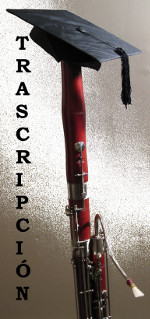Weissenborn Opus 8/2, Study #17 for advanced bassoon students. Using the alternate F# fingering. Stravinsky's healing. Guest performer Sojung Kwon Terry B. Ewell, Bassoon Digital Professor. BDP#125. www.2reed.net.
Weissenborn Opus 8/2, Estudio Avanzado #17. Posición alternativa de Fa#. Sanación de Stravinsky. Intérprete invitado: Sojung Kwon. Por Terry B. Ewell, Profesor Digital de Fagot. Traducido por Germán Martínez López. BDP #125. www.2reed.net
TUTORIAL
1. Welcome, this is Terry Ewell. In Study #17 Weissenborn does
not
give staccato markings at the end of slurred pairs. This is different
than Study #6 where staccato marks are given with each pair of slurred
notes.
1. Bienvenidos, soy Terry Ewell. En el Estudio #17,
Weissenborn no
pone indicaciones de staccato al final de las parejas de notas ligadas.
Esto es diferente al estudio #6, donde había indicaciones de
staccato con cada par de notas ligadas.

2. Therefore the eighth notes should be rather connected and
they
should be separated only briefly with the tongue between the slurs.
2.Por tanto, las corcheas deben estar conectadas y solo deben ser separadas brevemente, con la lengua, entre las ligaduras.
3. You will notice in line 4 that I have indicated two breaths quite
early in the phrase. This is in order to keep air in the lungs to
complete the phrase and also to avoid big gaps when breathing is needed
in line 5. Similar breathing choices are made later in the study as
well.
3. Os daréis cuenta de que en la línea 4 he indicado dos respiraciones bastante pronto en la frase. Esto tiene el fin de mantener aire en los pulmones para completar la frase, y también para evitar huecos o cortes cuando necesitemos respirar en la línea 5. Más adelante, en el estudio, haremos elecciones similares para respirar.
4. I have mentioned before that the quickest way to breathe is by
dropping the jaw not raising the head. I encourage you to practice this
study breathing that way.
4. Ya he mencionado antes que la forma más rápida de respirar es bajando la mandíbula, no levantando la cabeza. Os animo a practicar este estudio respirando de esta forma.
5. The alternate F# fingerings in line 7 are to help move to Bb3.
5. La posición alternativa de Fa# os
ayudará, en la línea 5, a moveros al Sib3.



6. There will be many examples in the Fifty Studies where
those two
notes (F# and Bb) are slurred. Leaping the thumb over the E key
(pancake key) will interrupt the slurs.
6.Habrá muchos ejemplos, en los 50 Estudios, en los
que esas
dos notas, Fa# y Sib, estarán ligadas. Mover el pulgar por
encima de la llave de Mi puede entorpecer la ligadura.
7. Practice the motion from the little finger F# to the thumb
Bb until you have mastered it.
7. Practicad el paso del meñique de la llave de Fa# al pulgar de la llave de Sib hasta que lo hayáis dominado.
REFLECTION沉思
8. I sat down, removed the little bandage, felt the pain had
suddenly stopped, and discovered that the finger
was—miraculously, it seemed to
me—healed.—Igor
Stravinsky
(Igor Stravinsky and Robert Craft, Dialogues and a Diary
(Garden City: Doubleday & Co., Inc., 1962), p. 9.)
8. Me senté, removí el
pequeño vendaje,
sentí que el dolor había cesado repentinamente, y
descubrí que el dedo había (milagrosamente, a mi
parecer)
sanado.-Igor Stravinsky.
9. We saw in the last video that J. S. Bach’s encounters with
God
are shown in his music and his study of the Bible. Igor
Stravinsky’s encounters with God were in different contexts.
9. En el último video vimos que los encuentros de
J. S. Bach
con Dios son mostrados en su música y estudio de la Biblia.
Los
encuentros con Dios de Igor Stravinsky sucedieron en contextos
diferentes.
10. Stravinsky gained great fame with his compositions of pagan rituals
and Russian folk tales in the 1910s. Later in the mid-1920s, however,
his spiritual life was transformed. Stravinsky stated that two items
led to his faith in God: 1) a convincing answer to a private prayer and
2) the healing of his finger immediately before a performance of his Piano
Sonata. These two experiences had such a profound effect on
his life that he dedicated his next major orchestral work, Symphony
of Psalms, to the glory of God.
10. Stravinsky ganó gran fama con sus composiciones
de
rituales paganos y cuentos populares rusos en la década de
1910.
Más tarde, a mediados de la década de 1920, su
vida
espiritual fue transformada. Stravinsky afirmó que dos cosas
lo
llevaron a su fe en Dios: 1) una convincente respuesta a una
oración privada y 2) la sanidad de su dedo inmediatamente
antes
de una función en la que interpretaría su Sonata
de
Piano. Estas dos experiencias tuvieron un efecto tan profundo en su
vida, que lo llevaron a dedicar su siguiente gran obra orquestal,
“Sinfonía de Salmos”, a la gloria de
Dios.
11. If you are interested in reading more about composer’s
encounters with God I recommend the book The Spiritual Lives
of Great Composers by Patrick Kavanaugh. There are many
musicians, well known and obscure, that have chosen to follow the
teachings of Jesus.
11. Si estas interesado en leer más acerca de compositores que se han encontrado con Dios, yo recomiendo el libro “La Vida Espiritual de Grandes Compositores” escrito por Patrick Kavanaugh. Hay muchos músicos, conocidos y no conocidos, que han elegido seguir las enseñanzas de Jesús.
CREDITS
Patrick Kavanaugh, The Spiritual Lives of Great
Composers (Nashville, Sparrow Press, 1992).
